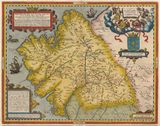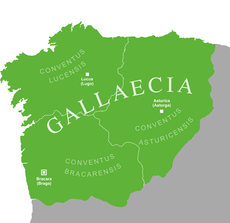Gallaecia
| History of Galicia | |
|---|---|
 This article is part of a series |
|
| Prehistoric Galicia | |
| Gallaeci (Celtic tribe) | |
| Roman Gallaecia | |
| Suebi Kingdom | |
| Brythonic Galicia | |
| Kingdom of Galicia | |
| The Compostela's Era | |
| Galician Modern Age | |
| Galicia in the 20th century | |
| Galicia at Present | |
|
Galicia Portal |
Gallaecia or Callaecia was the name of a Roman province and an early Mediaeval kingdom that comprised a territory in the north-west of Hispania (approximately present-day northern Portugal, and León (province), Asturias and Galicia in Spain). The most important city and historical capital of Callaecia was the town of Bracara Augusta, the modern Portuguese Braga.
Contents |
Description
The Romans gave the name Gallaecia to the northwest part of the Iberian peninsula after the Gallaeci (Greek Kallaikoi) tribe (or Gallaecians). These Gallaeci lived in the Douro Valley with center in Cale in the area that would become the Roman town of Portus Cale, today's Porto. [1] [2]
The wild Gallaic Celts make their entry in written history in the first-century epic Punica of Silius Italicus on the First Punic War:
- Fibrarum et pennae divinarumque sagacem
- flammarum misit dives Callaecia pubem,
- barbara nunc patriis ululantem carmina linguis,
- nunc pedis alterno percussa verbere terra,
- ad numerum resonas gaudentem plaudere caetras. (book III.344-7)
- "Rich Gallaecia sent its youths, wise in the knowledge of divination by the entrails of beasts, by feathers and flames— who, now crying out the barbarian song of their native tongue, now alternately stamping the ground in their rhythmic dances until the ground rang, and accompanying the playing with sonorous caetrae" (a caetra was a small type of shield used in the region).
Gallaecia, as a region, was thus marked for the Romans as much for its Celtic culture, the culture of the castros or castreja — hillforts of Celtic origin—as it was for the lure of its gold mines. This civilization extended over present day Galicia, the north of Portugal, the western part of Asturias, the Berço, and Sanabria.
| History of Portugal series |
|---|
|
| Topics |
|
| Timeline of Portuguese history |
At a far later date, the mythic history that was encapsulated in Lebor Gabála Érenn credited Gallaecia as the point from which the Gallaic Celts sailed to conquer Ireland, as they had Gallaecia, by force of arms.
History
Pre-Roman Gallaecia
Strabo in his Geography mentions that the ancient people called Lusitania to the lands north of river Douro, the land that in his own time was known as Gallaecia.[3] . On other way he also mentions that for their fighting spirit not only the Gallaeci gave the name to the man who defeated them and the lusitanians but also they made, for this, that the most of the lusitanians are called Gallaeci [4]
Roman Gallaecia

After the Punic Wars, the Romans turned their attention to conquering Hispania. The tribe of the Gallaeci 60,000 strong, according to Paulus Orosius, faced the Roman forces in 137 BC in a battle at the river Douro (Spanish: Duero, Portuguese: Douro, Latin: Durius), which resulted in a great Roman victory, by virtue of which the Roman proconsul Decimus Junius Brutus returned a hero, receiving the agnomen Gallaicus ("conqueror of the Gallaicoi"). From this time, Gallaic fighters joined the Roman legions, to serve as far away as Dacia and Britain. The final extinction of Celtic resistance was the aim of the violent and ruthless Cantabrian Wars fought under the emperor Octavian from 26 to 19 BC. The resistance was appalling: collective suicide rather than surrender, mothers who killed their children before committing suicide, crucified prisoners of war who sang triumphant hymns, rebellions of captives who killed their guards and returned home from Gaul.
For Rome Gallaecia was a region formed exclusively by two conventus—the Lucensis and the Bracarensis — and was distinguished clearly from other zones like the Asturica, according to written sources:
- Legatus iuridici to per ASTURIAE ET GALLAECIAE.
- Procurator ASTURIAE ET GALLAECIAE.
- Cohors ASTURUM ET GALLAECORUM.
- Pliny: ASTURIA ET GALLAECIA
In the 3rd century, Diocletian created an administrative division which included the conventus of Gallaecia, Asturica and, perhaps, Cluniense. This province took the name of Gallaecia since Gallaecia was the most populous and important zone within the province. In 409, as Roman control collapsed, the Suebi conquests transformed Roman Gallaecia (convents Lucense and Bracarense) into the kingdom of Galicia (the Galliciense Regnum recorded by Hydatius and Gregory of Tours).
Roman governors
- Fabius Aconius Catullinus Philomathius, praeses before 338
Later Gallaecia
In Beatus of Liébana (d. 798), Gallaecia refers to the Christian part of the Iberian peninsula, whereas Hispania refers to the Muslim one. The emirs found it not worth their while to conquer these mountains filled with fighters and lacking oil or wine.
In Charlemagne's time, bishops of Gallaecia attended the Council of Frankfurt in 794. During his residence in Aachen, he received embassies from Alfonso II of Asturias, according to the Frankish chronicles.
Sancho III of Navarre in 1029 refers to Vermudo III as Imperator domus Vermudus in Gallaecia.
See also
- Pre-Roman peoples of the Iberian Peninsula
- Kingdom of Galicia
- Timeline of Galician History
References
- ↑ Strabo, Geography, Book III, Chapter 3
- ↑ [Luján, Eugenio R. (2000): "Ptolemy's 'Callaecia' and the language(s) of the 'Callaeci', in Ptolemy: towards a linguistic atlas of the earliest Celtic place-names of Europe : papers from a workshop sponsored by the British Academy, Dept. of Welsh, University of Wales, Aberystwyth, 11-12 April 1999, pp. 55-72. Parsons and Patrick Sims-Williams editors.]
- ↑ Strabo, Geography, Book III, Chapter 4
- ↑ Strabo, Geography, Book III, Chapter 3
Bibliography
- Coutinhas, José Manuel (2006), Aproximação à identidade etno-cultural dos Callaeci Bracari, Porto.
External links
- Alfonso Carbonell Lombardero, "The Gaels in Gallaecia"
- Luís Magarinhos Igrejas, "Sobre a origem e significado das palavras Portugal e Galiza"
- Detailed map of the Pre-Roman Peoples of Iberia (around 200 BC)
- Rutas Arqueolóxicas do Eixo Atlántico - Roteiro Arqueológico do Eixo Atlântico
| Western Empire (395–476) | |||
|---|---|---|---|
| Praetorian Prefecture of Gaul |
Diocese of Gaul: Alpes Poeninae et Graiae • Belgica I • Belgica II • Germania I • Germania II • Lugdunensis I • Lugdunensis II • Lugdunensis III • Lugdunensis IV • Maxima Sequanorum Diocese of Vienne (later Septem Provinciae): Alpes Maritimae • Aquitanica I • Aquitanica II • Narbonensis I • Narbonensis II • Novempopulania • Viennensis Diocese of Spain: Baetica • Baleares • Carthaginensis • Gallaecia • Lusitania • Mauretania Tingitana • Tarraconensis Diocese of Britain: Britannia I • Britannia II • Flavia Caesariensis • Maxima Caesariensis • Valentia (369) |
||
| Praetorian Prefecture of Italy |
Diocese of Suburbicarian Italy: Apulia et Calabria • Bruttia et Lucania • Campania • Corsica • Picenum Suburbicarium • Samnium • Sardinia • Sicilia • Tuscania et Umbria • Valeria Diocese of Annonarian Italy: Alpes Cottiae • Flaminia et Picenum Annonarium • Liguria et Aemilia • Raetia I • Raetia II • Venetia et Istria Diocese of Africa†: Africa proconsularis (Zeugitana) | Byzacena • Mauretania Caesariensis • Mauretania Sitifensis • Numidia Cirtensis • Numidia Militiana • Tripolitania Diocese of Pannonia (later of Illyricum): Dalmatia • Noricum mediterraneum • Noricum ripense • Pannonia I • Pannonia II • Savia • Valeria ripensis |
||
| Eastern Empire (395–ca. 640) | |||
| Praetorian Prefecture of Illyricum |
Diocese of Dacia: Dacia Mediterranea • Dacia Ripensis • Dardania • Moesia I • Praevalitana Diocese of Macedonia: Achaea • Creta • Epirus nova| Epirus vetus | Macedonia I • Macedonia II Salutaris • Thessalia |
||
| Praetorian Prefecture of the East |
Diocese of Thrace: Europa • Haemimontus • Moesia II§ • Rhodope • Scythia§ • Thracia Diocese of Asia*: Asia • Caria§ • Hellespontus • Insulae§ • Lycaonia (370) • Lycia • Lydia • Pamphylia • Pisidia • Phrygia Pacatiana • Phrygia Salutaria Diocese of Pontus*: Armenia I* • Armenia II* • Armenia Maior* • Armenian Satrapies* • Armenia III (536) • Armenia IV (536) • Bithynia • Cappadocia I* • Cappadocia II* • Galatia I* • Galatia II Salutaris* • Helenopontus* • Honorias* • Paphlagonia* • Pontus Polemoniacus* Diocese of the East: Arabia • Cilicia I • Cilicia II • Cyprus§ • Euphratensis • Isauria • Mesopotamia • Osroene • Palaestina I • Palaestina II • Palaestina III Salutaris • Phoenice • Phoenice Libanensis • Syria I • Syria II Salutaris • Theodorias (528) Diocese of Egypt: Aegyptus I • Aegyptus II • Arcadia • Augustamnica I • Augustamnica II • Libya Superior • Libya Inferior • Thebais Superior • Thebais Inferior |
||
| Other territories | Taurica • Lazica (532/562) • Spania (552) | ||
| Notes | Provincial administration reformed by Diocletian, ca. 293. Praetorian prefectures established after the death of Constantine I. Empire permanently partitioned after 395. Exarchates of Ravenna and Africa established after 584. After massive territorial loss due to the Muslim conquests, the remaining provinces were superseded by the theme system in ca. 640–660, although they survived under the latter until the early 9th century * affected (boundaries modified/abolished/renamed) by Justinian's administrative reorganization in 534–536 † re-established after reconquest by the Eastern Empire in 534, as the separate praetorian prefecture of Africa § joined together into the Quaestura exercitus in 536 |
||